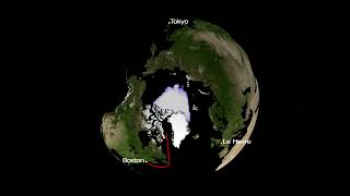Arctic video
updated 2021
The signs of climate change are becoming ever more apparent in the Arctic.The effects
of global warming are being felt in this region more quickly than anywhere else in the
world. The extent of sea ice has decreased significantly, dropping below 4 million sq.km. for the first time ever seen in September 2012. 2020 followed the same trend
with ice melting very early and record warm temperatures. New economic opportunities
and shipping lanes towards Asia are opening up for North America, through the North-West Passage, and for Europe through the North-East passage. If that’s so, it will be no pleasure cruise.With ice floes a constant threat, navigating will be fraught with danger
and the risk of an ecological disaster high in the event of a shipping accident.The Arctic
is also a new El Dorado for the nations encircling it as they eye up the continent’s vast
reserves of oil and gas.
In this context, monitoring by satellite is required.The French-Indian SARAL satellite in Ka-band, the European CryoSat satellite in Ku-band and the American Icesat-2 satellite with its laser altimeter are giving scientists new tools for analysis. First, they
are being used to map fracturing of ice to gauge sea ice status and tell us more about
how it is evolving over time.Fractured ice usually melts faster than an unbroken surface. Second, they will ultimately allow us to measure ice thickness more precisely.
Satellite monitoring of sea ice in the Arctic is set to continue, notably with the European Sentinel-3 satellite, to gauge the extent of climate change and reveal the true picture of our planet’s environment and climate.
https://www.aviso.altimetry.fr/en/applications/ice-and-cryosphere/sea-ice.html
Downloads
| File | Type | Size | Lang | Resolution | Creation date | Represented date |
|---|---|---|---|---|---|---|
| 03_arctic.jpg | Image | 4.51kb | 320x180 | 2021-10-01 | ||
| 03_arctic.mp4 | Video | 24.13Mb | en | 2021-10-01 | ||
| 03_arctic.pdf | Electronic document | 4.34Mb | en | 2021-10-01 | ||
| 03_arctique.mp4 | Video | 24.06Mb | fr | 2021-10-01 | ||
| 03_arctique.pdf | Electronic document | 4.33Mb | fr | 2021-10-01 |
- Geographic area : Arctic Ocean
- Instrument : Altimeter
- Parameter : Ice concentration, Ice drift, Ice thickness
- Topic : Sea Ice
- Satellite : Cryosat, Envisat, ERS-1 & 2, Saral



